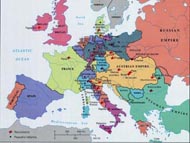 Click image to enlarge
Click image to enlarge
http://www.uiowa.edu/~c016003a/map1848.jpg
„Revolution, Revolutionsabwehr und Gegenrevolution verbanden 1848 Europa zu einer Einheit. In der Revolution und durch sie wuchs der Kontinent zu einem Kommunikations- und Handlungsraum zusammen und erreichte eine neue, zuvor nicht gekannte Informationsdichte […]. Die Möglichkeiten sich zu informieren, verbesserten sich für alle Bevölkerungskreise mit der Evolution schlagartig, und der Wille, sie zu nutzen, ebenfalls. Nie zuvor hatte ein so eng geknüpftes Informationsnetz Europa überzogen.
Die Europäisierung der Information ermöglichte die Revolutionierung Europas. Ausgelöst hatte diesen Prozess die Pariser Februarrevolution. […]
Europa bildete seine Vorstellungen an dem, was in Paris geschah, doch waren es eigenständige Revolutionen, mit je eigenen Ursachen, Zielen und Verlaufsformen, die 1848 den größten Raum des europäischen Kontinents erschütterten.“




Presentation
Beginning of the uprisings: Paris 23.2./ Mannheim 27.2./ Vienna 13.3./ Budapest 14.3./ Milano, Berlin 18.3./ Munich 20.3./ Venice 22.3./ Prague 17.6.